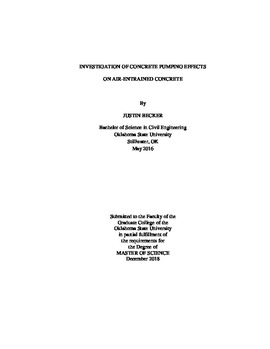| dc.contributor.advisor | Ley, Tyler | |
| dc.contributor.author | Becker, Justin | |
| dc.date.accessioned | 2019-07-19T14:08:48Z | |
| dc.date.available | 2019-07-19T14:08:48Z | |
| dc.date.issued | 2018-12-01 | |
| dc.identifier.uri | https://hdl.handle.net/11244/320968 | |
| dc.description.abstract | This work investigates how pumping affects the air void system in the fresh and hardened concrete. This work pumped a similar mixture design with varying air contents in laboratory and field environments to investigate the air void system before and after pumping. The Super Air Meter (AASHTO TP118) was used to give the air volume and SAM Number of the fresh concrete. The hardened concrete was evaluated using hardened air void analysis (ASTM C457) and freeze-thaw durability testing (ASTM C666). For the mixtures investigated, concrete pumping did not cause a significant change to the hardened air void system. The research conducted suggests the fresh air content and SAM Number measured after pumping on the fresh concrete is not representative of the hardened concrete. Because of this, it is suggested to sample fresh concrete prior to pumping to determine the quality of the air void system. The work also gives a framework for future testing. | |
| dc.format | application/pdf | |
| dc.language | en_US | |
| dc.rights | Copyright is held by the author who has granted the Oklahoma State University Library the non-exclusive right to share this material in its institutional repository. Contact Digital Library Services at lib-dls@okstate.edu or 405-744-9161 for the permission policy on the use, reproduction or distribution of this material. | |
| dc.title | Investigation of Concrete Pumping Effects on Air-Entrained Concrete | |
| dc.contributor.committeeMember | Russell, Bruce W. | |
| dc.contributor.committeeMember | Hartell, Julie Ann | |
| osu.filename | Becker_okstate_0664M_15956.pdf | |
| osu.accesstype | Open Access | |
| dc.description.department | Civil Engineering | |
| dc.type.genre | Thesis | |
| dc.type.material | Text | |
